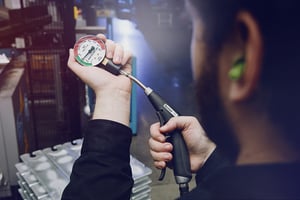A version of this article was first published on silvent.com
Two ways to prevent non-compliance of OSHA

Either by regulating the pressure by means of an air pressure reducer or a specially designed nozzle. The air gun can either reduce the pressure by means of a built-in pressure reducer or by the use of technology that reduces the pressure in the event of a total blockage.
To avoid non-compliance with OSHA 1910.242(b), the pressure must be under 30 psi when the air leaves the blowing system. An air pressure OSHA gauge is the easiest way to find out the air pressure.
|
OSHA regulations state the following about compressed air: 1. the pressure is lower than 30 psi (210 kPa) 2. chip guards and personal safety equipment are used. |
What does the OSHA regulation mean?
The downstream pressure of the air at the outlet of the air gun, nozzle, or pipe opening is not allowed to exceed 30 psi (210 kPa) for all static conditions. A higher static pressure could cause serious injury to the operator. Therefore, to minimise the risk of injury in the event of total blockage, the pressure at the blockage should be less than 30 psi (210kPa). An air pressure gauge is the easiest way to check air pressure.
Chip guards are used to protect the operator and people working in the vicinity from flying chips and particles. They can either be screens or other solutions to prevent eye and body injuries. It is important to keep in mind that some safety equipment only protects the operator and these may need to be supplemented in order to protect people nearby. Furthermore, personal safety equipment such as hearing protection and full-cover goggles must be used.
Silvent can help you eliminate the risk of non-compliance with OSHA, while maintaining an effective blowing force.



